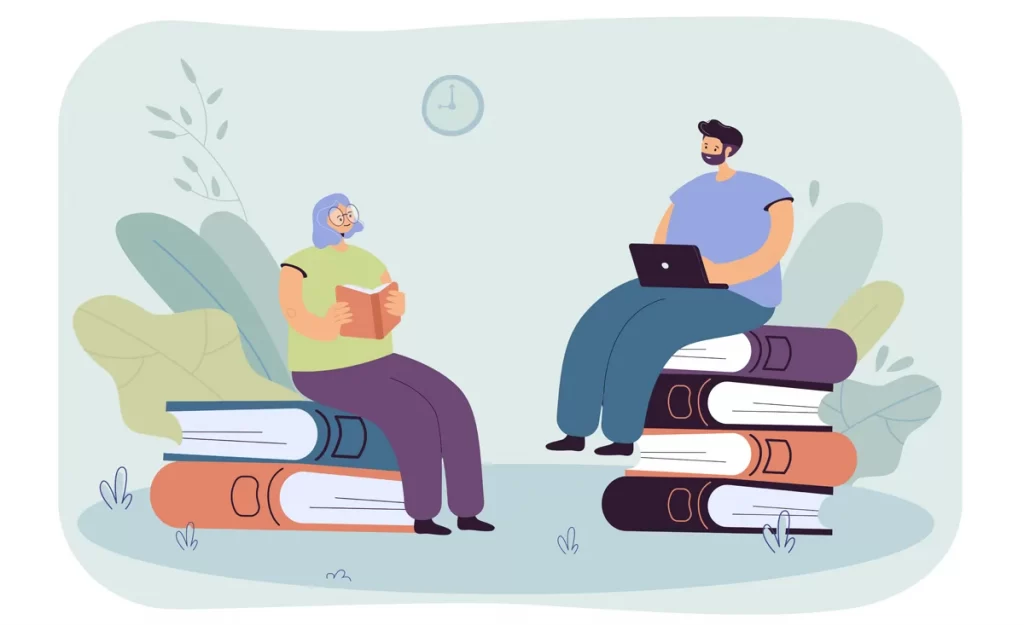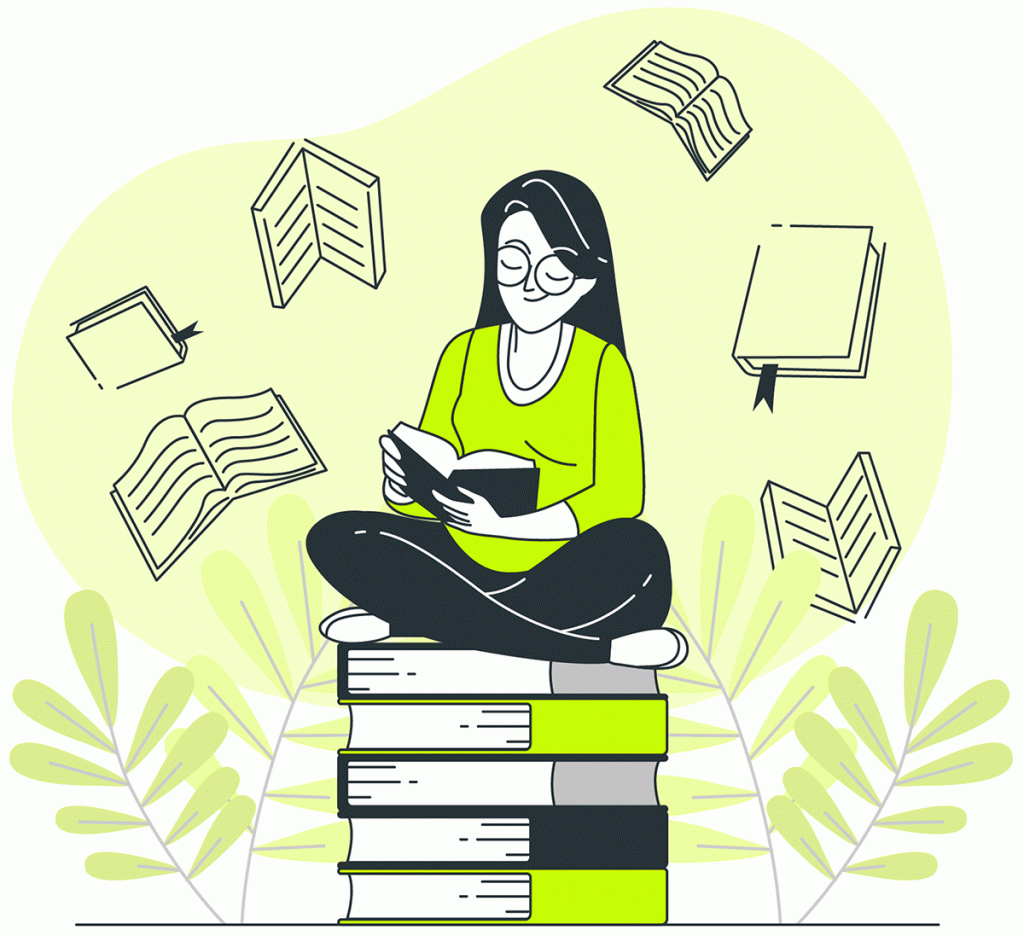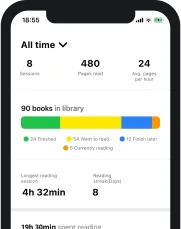Reading is a great way of improving your skills and developing your brain and how your mind works. As if reading in itself wasn’t stimulating enough, there are several techniques guaranteed to give you a mental boost.
Close reading, speed reading, and critical reading are some of the most popular ones.
But what is close reading exactly, what does the process of close reading help a reader do, and how to close read? Let’s find out together.
What Is Close Reading?
Close reading is referred to as a sustained and careful interpretation of a text. It is mainly a literary criticism tool and it involves dissecting every sentence, and paragraph of a text, understanding the meaning of every word and format structure, and every idea standing behind each sentence.
In many ways, close reading is the opposite of a book summary. While summarizing means extracting the main ideas and key points from a text and presenting them in a concise way, close reading involves a critical analysis and a more in-depth look at every aspect of a piece of writing.
Close reading, also known as practical criticism, is a technique mostly used in school and is a way of assessing the student’s abilities to understand the deeper meaning behind a certain text. While for many of us, the adventure of close reading ends the second the ring bells for the last time in our literature class in college, many still use it long after that, and for good reason.
To better understand the close reading meaning, we need to have a look at the process of close reading, some close reading strategies, and the goals of a successful practical criticism session.
What Is The Meaning Of Close Reading?
While the close reading definition does shed some light on what close reading actually is and what it involves in terms of what the reader is trying to achieve, its true meaning goes somewhat deeper.
To understand the meaning of close reading and what it represents in the life of a reader, you need to know not only how it should be done, but also what its goal is and what a reader should be aiming for in terms of results and personal development.
That being said, the best way to explain the close reading meaning is to look at it as the culmination of your reading experience. Close reading encapsulates every skill you acquire throughout your reading life and puts it to good use. Through close reading, you get to practice your analytical skills, you get to criticize the work of the author, and you read with a clear intent to fully understand and retain the information.
Nuances, details, syntax, punctuation, complexities, context, structure, and the greater meaning are all under your scope and the reading experience has more meaning to you, it puts you through a completely different process, and gets you to put a lot more effort into the activity.
Give Your Reading Experience
An Extra Boost With Basmo
Track the books you read, monitor the time you spend reading and keep notes on your reading habits and how it makes you feel. You can set yourself targets for the time you spend reading and you can get notified whenever you’re behind on your reading time.
What Is The Goal Of Close Reading?
So, what is the purpose of close reading? The expected goals of a successful close reading session are:
- To be able to understand the general information contained in a text even despite your inability to understand each particular word or concept in it.
- To be able to successfully identify writing techniques authors use to transmit the message, idea, or feeling to the reader and to be able to explain how each technique works and why it is used in that particular text.
- To be able to judge the effectiveness of said writing techniques and compare them with others and assess how well the author has managed to get the message across using these techniques.
Whether it’s a task assigned by a teacher, book club leader, or even yourself, close reading aims to be a critical technique that puts your understanding, general knowledge, and ability to interpret a literary message to the test.
It is a powerful learning tool for improving one’s ability to think critically and express interpretations and opinions, and the main goal is to develop how well and how fast our brain can understand a text and its meaning.
What Is the Importance of Close Reading?
Learning how to do a close reading session properly and how to extract maximum value from it is not only important, it is actually essential. The ability to close read and fully grasp the meaning of a text in every last detail can make a huge difference throughout your life, both academically and in daily activities. Here are some of the most relevant reasons why close reading is of utmost importance.
1. Close Reading Develops Critical Thinking Skills
From the analysis of the language used to uncover the true meaning of the text, close reading is a great exercise for our critical thinking skills. A close reading session is a great way to exercise our mental abilities and put our brains through an intense workout session.
Critical thinking is an extremely important skill. From the school years when we are required to use it in order to succeed, all the way up to everything we do in our daily lives now. Having the ability to properly understand and analyze a work email in order to perfectly understand the sender’s message and intentions can make a huge difference.
2. Improves Comprehension
During close reading sessions, your main focus is always going to be on comprehension. Reading the same paragraph several times until you are absolutely certain that you understand it not only in its entirety but down to every last detail will always ensure a good comprehension level in that particular session.
Comprehension is, like pretty much any other mental process, an acquired skill that can be developed and improved through practice. Better comprehension skills begin with actually understanding every single word we read, and finally result in a deep understanding of a text as a whole, including its meaning, the author’s intent, and the role of every single word in the context.
3. We Better Identify Literary Devices
Part of the way we understand and appreciate literature is through identifying, acknowledging, and deciphering literary devices. Close reading forces us to pay attention to every single detail in a literary piece, which means we fully grasp not only what the text is about, but also the techniques used by the author to get the message across.
This can be a great way to gain a deeper understanding of what each writer is doing in particular and how each one constructs his own style. Close reading can make us more receptive to metaphors and other writing techniques which in turn allow us to better appreciate what we read. Not only that, but this newly gained understanding and ability to identify literary devices while reading can help us criticize literature with more accuracy.
4. Improves Writing Skills
Moving one step further from identifying and understanding literary devices, making a habit out of having close reading sessions at least once in a while can also have a positive effect on our writing skills.
The improvements come from a series of factors. First of all, by paying attention to the way writers build sentences and paragraphs to get their message across, we subconsciously become more proficient in doing exactly that. Close reading will help us better understand literary devices, which means will be able to use them as well while writing.
On top of this, as I will expand further below, close reading has a positive effect on vocabulary development as well. Always having the right words locked and loaded to properly deliver the message we want to deliver is definitely going to make our writing a lot better.
5. Close Reading Enables Us to Find Hidden Meanings
Not everything is what it seems, that is something we all know very well. But reading is definitely one activity where this becomes clearer than ever. There is a hidden meaning behind so many things you read.
Close reading is probably the best technique to use in order to be able to uncover the true meaning of the written text. Uncovering the hidden messages and hidden meanings while reading enhances our overall experience and makes us feel closer to the author.
Not only that, but we also gain a deeper understanding of what we are reading and that makes us feel more involved in the story. We go deeper into the action, we related to a more personal level with the characters, and we, therefore, add another level to our reading experience.
6. Close Reading Enhances Vocabulary
Since close reading means paying full attention and being completely immersed in what we are reading, this also includes taking every word as a separate entity and understanding its meaning. This will help us significantly improve our vocabulary.
The more focused we are and the more attention we pay to whatever it is we are reading, the more likely it is for us to discover unfamiliar words. If we go the extra mile to understand their meaning not only from context but also by looking them up in a dictionary, we significantly increase our chances of actually remembering them and using them in later conversations or in writing.
7. Close Reading Deepens Appreciation for Books and Literature
While many of us read mostly for the experience of reading, to enjoy the relaxation and other benefits, many other readers out there do it out of pure love for literature and books. These are generally those of us who engage more often in close reading sessions.
That’s because close reading is known to increase our love for books and deepen our appreciation for literature. Some books have a lot more meaning than you would be able to grasp through regular reading and only through close reading can you truly understand and appreciate their value.
How to Do Close Reading?
A list of particular close reading techniques is rather hard to make given the complexity of the task. Close reading is a process more than anything and the best way to approach it is to divide it into a couple of steps. Here’s the best way to do it.
Step 1. Reading and Taking Notes
The first step in the process of close reading is to analyze a text from a certain point of view (either as instructed by whoever issued the close reading task or through your own perspective). This may include analyzing all characteristics of a text that make it stand out, be it structural elements, cultural references, active or passive voice proportions, particular metaphors, rhetorical features, or even historical references.
Pay attention to how the language is used, what particularities stand out, what the meaning of each word is, what the author’s tone is, and whether it changes throughout the paragraph. Determine what themes appear in the text, whether certain patterns or words are repeated, and what the meaning behind these repetitions could be.
Taking notes at this stage is essential because it helps you remember the important aspects of the text and will make it a lot easier for you to answer any questions about the passage you’re analyzing. While using a pen and paper is obviously acceptable, the best way to take notes is using a reading tracking app on your smartphone or tablet.
Basmo for example offers its users the option to take digital notes while a reading session is ongoing within the app.
So, after analyzing a text, you can write your notes directly in the app.
Several formatting options are also available, meaning that you can separate your notes into different subjects, and you can underline or highlight your conclusion so that it is easier for you to keep track of your thoughts later on.
Step 2. Analysis
Once you’ve noticed the particular elements you’re looking for, the second step is interpreting them through inductive reasoning. This means the process moves from an observational stage to a personal interpretation or conclusion based on previously made observations.
Think about all the aspects of the text you’re analyzing. Do you know all the words? How are words being used to induce a certain emotional state in the reader? What does the author focus on? Try to put yourself in the author’s position and try to understand how the writer came to that particular phrasing and why.
Again, using Basmo has a lot of benefits. The notes you make during this stage can also be saved in the app and you can easily get access to them later on with just a couple of taps.
Step 3. Descriptive Thesis
Once you’ve read and analyzed the text, use your notes to start writing your view about the passage you’re close reading. In this step, you should be attempting to make a summary of your observations from Step one. Jot down your thoughts about how language is being used in the given passage.
This should be an analytical section, focused on the HOW. Explain the particularities of the text, the techniques used, and their role.
Step 4. Your Argument
This is where your own judgment comes into play. This step is focused on the WHY. Take your previous observations and analyze them further, beyond the technicalities and try to explain why you think the author expressed the ideas, thoughts, and feelings the way he did.
Try to understand how the language connects to the themes that appear in the passage, why the author is using certain writing techniques, and the particular tone, and construct your own argument about the passage you’ve been close reading.
Describe the words used (are they intellectual, plain, vulgar?), the sentence length and why you think the author chose it, who is actually “speaking” in the passage, does the text allow you to visualize what you’re reading, how emotional or detached the tone is and the effect it has on the reader’s experience.
Step 5. Conclusion
As the title suggests, this is where you should draw your conclusions about the text you’ve analyzed and described. Try to emphasize your own opinion about the passage, how YOU interpreted it, and what YOU felt while reading it.
Focus on the quality of the writing, give your honest opinion about the writing techniques used and the value they bring to the text, and their effectiveness in getting the desired message across. You may even mention if there is anything you would have done differently if you were the author.
Concrete examples are essential in this stage, so don’t hesitate to use quotes whenever you feel they would help emphasize your ideas.
Basmo can be of great help with this as well.
Users can save quotes from the text they’re reading and analyzing by using the page scanning feature, which can extract the text directly from a book using your device’s camera. All you have to do is scan the page, select the text you’re interested in, and save it as a note or as an image for later use.
By following all these steps and choosing to use Basmo every step of the way, you will get a very detailed overview of your close reading session. Basmo will be your trusted companion throughout the whole process and you will always have access to the notes you take or quotes you save.
What Are the Benefits of Close Reading?
While many consider close reading to be a simple assignment in school, others consider it an essential life skill. And for good reason.
Close reading develops critical thinking in readers of all ages. It helps develop the ability to understand what a text says, how the text is constructed, and what the meaning behind it is.
Even as adults, we close read on a daily basis, many times without even realizing it. We analyze work emails, text messages, and IMs to make sure we understand both the message and the sender’s expectations of us. We analyze product descriptions online before buying a product, we pay attention to advertisements and try to decide whether what they are trying to sell is what we actually need.
This “detective work” behind understanding every aspect of a text is clearly an essential life skill and one that we use more than we can imagine. Proper training is done in school, but that doesn’t mean we shouldn’t try to improve ourselves even later in life.
Needless to say, this is a complex process and one that activates many parts of our brains. You read, analyze, write down your thoughts, interpret the meaning behind the text, and construct your own interpretation. Close reading is like a whole-body workout for your brain and regular sessions will keep your brain in top shape.
What Are Some Examples of Close Reading Questions?
Finding close reading examples could help you get a better idea of how to organize and construct your argument, but that isn’t nearly as important as the close reading questions.
A key aspect of successful close reading is knowing what questions to ask yourself while analyzing the text and what questions might be asked of you while developing your argument.
Here are a couple of the most important things you need to pay attention to.
Diction questioning:
- What words does the author use and why?
- Are words being repeated?
- How are descriptions built? What adjectives describe which nouns and how do they influence your understanding of the message?
- What word connections do you notice?
Narrative Voice questioning:
- Who is narrating the text?
- What is the narrative perspective used and why?
Tone questioning:
- Is the author being open and straightforward?
- Is he or she trying to send the message in a less direct way?
- How emotional or detached is the tone?
- Do you feel any irony in the tone used? Where and why do you think irony is used?
Rhetorical and Literary device questioning:
- Is figurative language present? Do any metaphors stand out?
- Does the text “paint a picture”? Can you “see” what the author is describing?
- Does the text rhyme? Are the words used in a way that makes them sound important?
- What effect do these techniques have on the reading experience? Do they help get the message across, or do they try to hide the real meaning behind the text?
Being able to answer these questions, whether it’s in the first stages of the close reading when you’re mentally analyzing the text and formulating your argument or by the end of the session is extremely important. Knowing what to look for always makes the search easier.
Conclusion
Close reading is a complex and important process in our education and mental development. Regardless of our age, the improvements in our critical thinking it brings are priceless.
Always use Basmo for your close reading sessions and enjoy the benefits it offers:
- Easier note taking
- Facile quotes saving
- Better reading scheduling
- Reading goals
- Reading statistics and much more







